2046ss06
2046ss06.docx
NESHAP for Mercury Cell Chlor-Alkali Plants (40 CFR part 63, subpart IIIII) (Supplemental Proposed Rule)
OMB: 2060-0542
STANDARD FORM 83-I SUPPORTING STATEMENT
FOR OMB REVIEW OF ICR No. 2046.06
INFORMATION COLLECTION REQUEST FOR NATIONAL EMISSION STANDARDS FOR HAZARDOUS AIR POLLUTANTS: MERCURY CELL CHLOR-ALKALI PLANTS
U.S. ENVIRONMENTAL PROTECTION AGENCY
SECTOR POLICIES AND PROGRAMS DIVISION
RESEARCH TRIANGLE PARK, NORTH CAROLINA 27711
PART A OF THE SUPPORTING STATEMENT
1. IDENTIFICATION OF THE INFORMATION COLLECTION
a. Title and Number of the Information Collection
" NESHAP for Mercury Cell Chlor-Alkali Plants (40 CFR part 63, subpart IIII)." This is a revised information collection request (ICR) and the tracking number is EPA ICR No. 2046.06.
b. Short Characterization
This ICR is prepared for a U.S. Environmental Protection Agency (EPA) rulemaking developed under authority of section 112 of the Clean Air Act (CAA). The proposed rulemaking would amend title 40, chapter I, part 63, subpart IIIII, National Emission Standards for Hazardous Air Pollutants from Mercury Cell Chlor-Alkali Plants, of the Code of Federal Regulations (CFR). Hereafter, this subpart is referred to as the "Mercury Cell Chlor-Alkali NESHAP." The current Mercury Cell Chlor-Alkali NESHAP includes standards for major and area sources of hazardous air pollutants (HAP). The proposed amendments are in response to a petition to reconsider several aspects of the rule from the Natural Resources Defense Council (NRDC). These proposed requirements would prohibit emissions of mercury, which facilities could meet by either converting to non mercury technology or ceasing their chlorine production operations. A major source of HAP is one that has the potential to emit, considering controls (in place under a federally enforceable agreement), 10 tons or more of anyone HAP or 25 tons or more of total HAP per year; an area source is one with a potential to emit less than this. Respondents are owners or operators of processes and operations of affected sources in the mercury cell chlor-alkali source category. All sources must be in compliance with the requirements of the proposed amendments rule by three years after the effective date of the amended final rule.
This ICR is for major and area sources of HAP emissions in the mercury cell chlor-alkali subcategory of the chlorine production source category. This ICR is based on four existing mercury cell chlor-alkali plants in the United States which were considered to be a part of the mercury cell chlor-alkali plant source category for regulatory development and would be required to comply with the mercury cell chlor-alkali NESHAP within 3 years of the effective date (promulgation date). It is believed that no new mercury cell chlor-alkali plant will be constructed. Future demand for chlor-alkali production is anticipated to be met using other chlor-alkali cell types which do not result in mercury emissions. Therefore, no new or reconstructed plants were considered in this ICR.
The period considered in this ICR and throughout this supporting statement is the first three years following the compliance date of the amended mercury cell chlor-alkali NESHAP, which would be years four through six after the effective date. As noted above, the result of these proposed amendments would be that each of the four mercury cell chlor-alkali plants that are currently in operation would convert to a non-mercury technology or close. The only monitoring, recordkeeping, or reporting requirement in the proposed rule is the submittal of a one-time report 60 days following the compliance date which certifies that all mercury emissions have been eliminated. The total monitoring, inspecting, reporting, and recordkeeping (MIRR) costs for existing sources during the first three years after the compliance date are estimated to be $798. All these costs are for labor dollars in the three years following the compliance date, as there are no capital and operation and maintenance (O&M) for the first three years. The annual costs for each of the first three years after promulgation are not expected to be equal. In fact, all of these costs will be incurred in the first year. There will be no MIRR costs in years 2 and 3, as there are no MIRR requirements after the submittal of the certification of zero mercury emissions in year one. See section 6 for more details on cost estimates.
Note that this ICR covers one of two options of the proposal. The first option was covered in a published FR notice dated June 11 2008 (73 FR 33258) but is being republished with this proposal. The ICR for the first option was submitted to OMB on June 1, 2008.
2. NEED FOR AND USE OF THE COLLECTION
a. Need/Authority for the Collection
We have been directed by section 112 of the CAA to regulate the emissions of HAP from stationary sources. Section 112(c)(1) of the CAA requires us to list categories and subcategories of major and area sources of HAP and to establish NESHAP for the listed source categories and subcategories. The chlorine production source category contains major sources of HAP emissions and is included on our list of categories scheduled for regulation. In addition, section 112(c)(6) requires us to list source categories and subcategories assuring that sources accounting for not less than 90 percent of the aggregate emissions of each of seven specific pollutants (including mercury) are subject to standards under section 112(d) of the CAA. Chlor-alkali production was among the categories of sources identified under 112(c)(6) to achieve the 90 percent emission reduction goal for mercury. While this category was titled as “chlor-alkali production,” the only sources of mercury emissions are mercury cell chlor-alkali plants. However, the mercury cell chlor-alkali subcategory was not officially “listed” under 112(c)(6) because the chlorine production source category was already listed under 112(c)(1) and would be subject to 112(d)(2) standards via that chlorine production source category listing.
The HAP identified as being emitted from mercury cell chlor-alkali sources are mercury, chlorine, and hydrogen chlorine (HCl). We have used our authority under section 112(d)(4) of the CAA to not regulate chlorine and HCl emissions from mercury cell chlor-alkali sources. Therefore, the only HAP being regulated by the final amended rule is mercury.
Section 112(d) requires us to promulgate regulations establishing emission standards for each category or subcategory of major sources and area sources of HAP listed pursuant to section 112(c). Section 112(d)(2) specifies that emission standards promulgated under the section shall require the maximum degree of reductions in emissions of the HAP subject to section 112 that are deemed achievable (the maximum achievable control technology, or MACT) taking into consideration the cost of achieving the emission reduction, any non-air quality health and environmental impacts, and energy requirements. Section 112(d)(4) provides for consideration of health thresholds with an ample margin of safety. Certain other sections of section 112 require the EPA, in addition to technology-based standards, to evaluate risk to public health and the environment in determining whether other control measures are appropriate.
Section 114 of the CAA gives us authority to collect data and information necessary to enforce standards established under section 112 of the CAA. Certain records and reports are necessary to enable the Administrator to (1) identify existing and new emission sources subject to the mercury cell chlor-alkali NESHAP, and (2) ensure that the requirements specified for an affected source subject to the mercury cell chlor-alkali NESHAP, which are based on maximum achievable control technology (MACT), are being achieved.
b. Use/Users of the Data
The information will be used by the EPA's enforcement personnel to confirm that these mercury cell chlor-alkali plants have eliminated all mercury emissions by either converting to non-mercury technology or closing.
3. NONDUPLICATION, CONSULTATIONS, AND OTHER COLLECTION CRITERIA
a. Nonduplication
A search of our existing standard and ongoing ICRs revealed some overlap in information gathering efforts between the mercury cell chlor-alkali NESHAP and a federal rule. We originally promulgated the “National Emission Standard for Mercury” on April 6, 1973 (See 40 CFR part 61, subpart E, §61.50 et. seq.).1 This standard (hereafter referred to as the part 61 NESHAP) limits mercury emissions from mercury chlor-alkali plants as well as mercury ore processing facilities and sludge incineration and drying plants. Upon the compliance date of the final mercury cell chlor-alkali NESHAP in 2003, mercury cell chlor-alkali plants neither had any obligation nor any ability to comply with the part 61 NESHAP. Further, the result of the current amendments would result in the complete elimination of mercury emissions. Therefore, there would effectively be no duplication of information-gathering efforts among our existing standards and ongoing ICRs.
b. Public Notice Required Prior to ICR Submission to OMB
Because this is a rule-related ICR, it is not necessary to solicit public comments prior to submittal of this ICR to OMB. However, a 60-day public comment period will be provided after promulgation of the final amendments to the mercury cell chlor-alkali NESHAP in the Federal Register, during which all affected parties will be given the opportunity to comment on the proposed amendments to the mercury cell chlor-alkali NESHAP. All comments that are received will be considered and some changes in response to the comments may be reflected in the final amendments to the mercury cell chlor-alkali NESHAP.
c. Consultations
OMB regulations require periodic consultation with respondents and data users such as members of industry as well as State and local governments. We consulted with representatives of the three companies operating mercury cell chlor-alkali plants throughout the mercury cell chlor-alkali NESHAP development process (Olin Corporation; PPG Industries, Incorporated; and ASHTA Chemicals, Incorporated).
A 60-day public comment period will be provided after proposal, during which all affected parties will be given the opportunity to comment on the proposed amendments to the mercury cell chlor-alkali NESHAP. All comments will be considered, and some may be reflected in the development of the final amendments.
d. Effects of Less Frequent Collection
The proposed amendments only require a single information collection event – the submittal of a certification that mercury emissions have been eliminated. If the relevant information were collected less frequently (i.e., not at all), the EPA would not be reasonably assured that a source is in compliance with the mercury cell chlor-alkali NESHAP. In addition, the EPA's authority to take administrative action would be reduced significantly.
Section 113(d) of the CAA limits the assessment of administrative penalties to violations which occur no more than 12 months before initiation of the administrative proceeding. Since administrative proceedings are less costly and require use of fewer resources than judicial proceedings, both the EPA and the regulated community benefit from preservation of the EPA's administrative powers.
e. General Guidelines
The mercury cell chlor-alkali NESHAP requires that facility owners or operators retain records for a period of five years, which exceeds the three year retention period contained in the guidelines in 5 CFR 1320.6. The five year retention period is consistent with the provisions of the General Provisions of 40 CFR part 63, and with the five year records retention requirement in the operating permit program under title V of the CAA. All subsequent guidelines have been followed and do not violate any of the Paperwork Reduction Act guidelines contained in 5 CFR 1320.6.
f. Confidentiality
All information submitted to the EPA for which a claim of confidentiality is made will be safeguarded according to the EPA policies set forth in title 40, chapter 1, part 2, subpart B, Confidentiality of Business Information. See 40 CFR 2; 41 FR 36902, September 1, 1976; amended by 43 FR 3999, September 8, 1978; 43 FR 42251, September 28, 1978; and 44 FR 17674, March 23, 1979. Even where the EPA has determined that data received in response to an ICR is eligible for confidential treatment under 40 CFR part 2, subpart B, the EPA may nonetheless disclose the information if it is "relevant in any proceeding" under the statute [42 U.S.C. '7414 (C); 40 CFR 2.301 (g)]. The information collection complies with the Privacy Act of 1974 and Office of Management and Budget (OMB) Circular 108.
g. Sensitive Questions
Information to be reported consists of information that are not of a sensitive nature. No sensitive personal or proprietary data are being collected.
4. THE RESPONDENTS AND THE INFORMATION REQUESTED
a. Respondents/SIC and NAICS Codes
Respondents are owners or operators of all existing and new mercury emitting affected sources in the mercury cell chlor-alkali subcategory of the chlorine production source category. The source category and affected sources regulated by the mercury cell chlor-alkali NESHAP are classified in the four‑digit Standard Industrial Classification (SIC) Codes 2812, "Alkalis and Chlorine." The corresponding North American Industrial Classification System (NAICS) code is 325181, “Alkalis and Chlorine Manufacturing.” A total of four existing mercury cell chlor-alkali plants in four States (Georgia, Ohio, Louisiana, and Tennessee) were considered to be part of the source category for regulatory development. Because no growth is expected in the industry, no new or reconstructed plants were considered as respondents.
b. Information Requested
The proposed amendments prohibit mercury emissions. Continuous compliance is achieved by operating without mercury emissions. After conversion to a non-mercury technology or closure, there is no other activity that is necessary to comply.
i. Data items, including recordkeeping requirements
The mercury cell chlor-alkali NESHAP requires the owner or operator to submit certain reports and maintain certain records as specified in the NESHAP, and in the General Provisions (40 CFR 63 subpart A). These activities are listed in Attachment 1. All reports must be submitted to the respondent's State agency, if it has an approved title V permit program implementation authority, or to the appropriate EPA Regional Office. Records must be retained for 5 years and must be maintained on-site, or readily accessible from on-site through a computer or other means, for at least 2 years after the date of each occurrence, measurement, maintenance, corrective action, report, or record. Records may be kept offsite for the remaining 3 years but must be made readily available upon request.
ii. Respondent Activities
The activities that would be performed by respondents to meet the MIRR requirements of the mercury cell chlor-alkali NESHAP for each of the first 3 years following promulgation of the final amendments are presented in Tables 1a through 1c. The respondent activities are also listed in Attachment 1.
This ICR assumes that all sources will submit the compliance certification that they have achieved zero mercury emissions and maintain a copy of this certification for their records. It is assumed that this activity will occur in the first year following the compliance date. In the second and third years, this ICR assumes there will be no burden since there are no requirements.
5. THE INFORMATION COLLECTED‑‑AGENCY ACTIVITIES, COLLECTION METHODOLOGY, AND INFORMATION MANAGEMENT
a. Agency Activities
A list of the EPA's activities for each of the first three years after promulgation is provided in Tables 3a through 3c, which are introduced in section 6(c). Table 4 summarizes the EPA=s estimated labor hours and cost over the first three years after promulgation. The Agency=s activities conducted in connection with the acquisition, analysis, storage, and distributed of the required information include: (1) receiving and reviewing the zero mercury compliance certifications and (2) conducting enforcement actions.
b. Collection Methodology and Management
Information contained in the one-time only report will be entered into the Aerometric Information Retrieval System (AIRS) Facility Subsystem (AFS) that is maintained and operated by the EPA's Office of Air Quality Planning and Standards (OAQPS). Data obtained during periodic visits by EPA personnel from records maintained by the respondents will be tabulated and published for internal EPA use in compliance and enforcement programs.
c. Small Entity Flexibility
Minimizing the information collection burden for all sizes of organizations is a continuing effort on the EPA's part. We have reduced the recordkeeping and reporting requirements to include only the information needed by the EPA to determine compliance with the mercury cell chlor-alkali NESHAP.
By definition, a small business is any business that is independently owned and operated and not dominant in its field as defined by the Small Business Administration (SBA) regulations under Section 3 of the Small Business Act. For the mercury cell chlor-alkali industry, a small business is defined by the number of employees, and the small business threshold is 1,000 or fewer employees (65 FR 53533).
One of the four three operating the five mercury cell chlor-alkali plants in the United States is considered a small entity. However, the proposed amendments to the mercury cell chlor-alkali NESHAP are not expected to have significant economic impact on small entities, and small business considerations would not apply.
d. Collection Schedule
Collection of data will begin after the compliance date of the amendments for mercury cell chlor-alkali NESHAP amendments, which is three years after the final amendments are published in the Federal Register. The compliance certification of zero mercury emissions is to be submitted 60 days following the compliance date.
6. ESTIMATING BURDEN AND COST OF THE COLLECTION
a. Estimating Respondent Burden
The annual burden for respondent activities includes labor cost, capital/startup cost, and O&M cost. EPA’s estimates of total burden for respondents for each of the first three years after promulgation of the amendments to the mercury cell chlor-alkali NESHAP are presented in Tables 1a through 1d.
b. Estimating Respondent Costs
i. Estimating labor costs
The estimates of total technical labor hours per year per source and the number of activities per respondent per year listed in each of Tables 1a through 1d are based upon experience with similar information collection requirements in other standards development efforts and the number of emission points in each source. Activities that are one-time-only activities are identified as such in the tables.
The estimated costs of the activities listed in Tables 1a through 1d were based on data from the U.S. Bureau of Labor Statistics= (BLS) Internet web site (http://www.bls.gov/oes/current/naics4_325100.htm), May 2006 National Industry-Specific Occupational Employment and Wage Estimates (Accessed May 2, 2008). Labor costs were divided into the following three categories: (1) technical, (2) managerial, and (3) clerical. Managerial and clerical labor hours were calculated as 5 and 10 percent, respectively, of each technical labor hour requirement. In addition, the labor rates were increased by 34.4 percent to account for fringe benefits, according to the BLS (http://www.bls.gov/news.release/pdf/ecec.pdf, Table 6). In addition, these values were multiplied by a factor of 1.1 to account for overhead costs. Therefore, the labor costs were estimated to be $122.52 per hour for managerial ($43.41 base labor rate), $69.52 per hour for technical ($24.63 base labor rate), and $14.56 per hour for clerical ($19.70 base labor rate).
ii. Estimating capital/startup and operation and maintenance (O&M) costs
There are no capital/startup and operation and maintenance costs associated with the proposed amendments.
c. Estimating the EPA's Burden and Cost
Because the information collection requirements were developed as an incidental part of mercury cell chlor-alkali NESHAP, no costs can be attributed to the development of the information collection requirements. Because recordkeeping and reporting requirements on the part of the respondents are required under section 112 of the CAA, no operational costs will be incurred by the Federal government. Publication and distribution of the information are part of the AFS operated and maintained by the EPA's OAQPS, with the result that no Federal costs can be directly attributed to the ICR. Examination of records to be maintained by the respondents will occur incidentally as part of the periodic inspection of sources that is part of the EPA's overall compliance and enforcement program and, therefore, is not attributable to the ICR.
The only costs that the Federal government will incur are user costs associated with analyzing the reported information, as presented in Tables 3a through 3c. Labor rates and associated costs are based on the 2010 General Schedule (GS) base salary data from the U.S. Office of Personnel Management Internet website (http://www.opm.gov/oca/10tables/pdf/gs_h.pdf), accessed March 4, 2010. We estimated hourly labor costs of $62.27 per hour (GS-13, Step 5; $38.92 x 1.6) for management, $46.21 per hour (GS-12, Step 1; $28.88 x 1.6) for technical, and $25.01 per hour (GS-6, Step 3; $15.63 x 1.6) for administrative. Labor rates include an additional 60 percent for overhead expenses, the standard government benefits multiplication factor. The federal burden and cost are summarized in Table 4.
d. Estimating the Respondent Universe and Total Burden and Costs
To calculate the total burden for respondents, the number of respondents (the respondent universe) to complete each activity was estimated. The burden for each activity was calculated by multiplying the per-respondent burden per activity by the number of respondents.
The respondent universe varies among the activities listed in Tables 1a through 1c, because not all respondents must complete each activity each year. The total burden and costs are summarized in Table 2.
e. Bottom Line Burden Hours and Costs
i. Respondent tally
The bottom line respondent burden hours and costs are summarized in Table 2. The estimated total nationwide burden in the first three years after the compliance date for the amendments to the mercury cell chlor-alkali NESHAP are an estimated 11.5 total labor hours and $798. The total estimated annual labor hour reporting and recordkeeping burden for the first three years is 3.8 labor hours per year.
The estimated annualized capital costs and annual O&M costs to comply with the standards were estimated to be $0, and the total capital and O&M costs for the first three years after promulgation of the amendments are estimated to $0.
ii. The EPA tally
The bottom line Federal government burden hours and costs that would result from this ICR in the first three years after promulgation of the amendments to the mercury cell chlor-alkali NESHAP are presented in Tables 3a through 3c. Estimated hours and costs in the first three years after promulgation are 4.6 total labor hours and $207. Table 4 summarizes the Federal government burden hours and costs for the mercury cell chlor-alkali NESHAP over the first three years after promulgation of the amendments.
iii. Variations in the annual bottom line
Variation in the annual bottom line for this regulation may occur over the first three years following promulgation of the amendments to this rule because the single ne-time activities would typically occur prior to the source=s compliance date and (2) it is not until the end of the third year following promulgation that all sources must be in compliance and will be subject to recurring recordkeeping and reporting requirements.
f. Reasons for Change in Burden
This section does not apply, because this is a new collection.
g. Burden Statement
The total three-year monitoring, reporting, and recordkeeping burden for this collection is estimated at 11.5 labor hours, and the annual average burden is 3.8 labor hours. Capital/Startup and O&M costs are estimated to be $0. The hour burden estimate includes time to submit the one-time certification of compliance with zero mercury emissions and time to file the report. The cost burden estimate includes the cost of labor hours.
Burden means the total time, effort, or financial resources expended by persons to generate, maintain, retain, or disclose or provide information to or for a Federal Agency. This includes the time needed to review instructions; develop, acquire, install, and utilize technology and systems for the purpose of collecting, validating, and verifying information, processing and maintaining information, and disclosing and providing information; adjust the existing ways to comply with any previously applicable instructions and requirements; train personnel to respond to a collection of information; search existing data sources; complete and review the collection of information; and transmit or otherwise disclose the information. An agency may not conduct or sponsor, and a person is not required to respond to, a collection of information unless it displays a currently valid OMB control number. The OMB control numbers for EPA’s regulations are listed in 40 CFR part 9 and 48 CFR chapter 15.
To comment on the Agency's need for this information, the accuracy of the provided burden estimates, and any suggested methods for minimizing respondent burden, including the use of automated collection techniques, EPA has established a public docket for this ICR under Docket ID Number EPA-HQ-OAR-2002-0017, which is available for online viewing at www.regulations.gov, or in person viewing at the Air Docket in the EPA Docket Center (EPA/DC), EPA West, Room 3334, 1301 Constitution Avenue, NW, Washington, D.C. The EPA Docket Center Public Reading Room is open from 8:30 a.m. to 4:30 p.m., Monday through Friday, excluding legal holidays. The telephone number for the Reading Room is (202) 566-1744, and the telephone number for the Air Docket is (202) 566-1742. An electronic version of the public docket is available at www.regulations.gov. This site can be used to submit or view public comments, access the index listing of the contents of the public docket, and to access those documents in the public docket that are available electronically. When in the system, select “search,” then key in the Docket ID Number identified above. Also, you can send comments to the Office of Information and Regulatory Affairs, Office of Management and Budget, 725 17th Street, NW, Washington, D.C. 20503, Attention: Desk Officer for EPA. Please include the EPA Docket ID Number EPA-HQ-OAR-2002-0017 and OMB Control Number 2060-0542 in any correspondence.
PART B OF THE SUPPORTING STATEMENT
Not applicable. No sampling or other methods are used to select respondents because all owners and operators of facilities subject to the mercury cell chlor-alkali NESHAP are required to collect information.
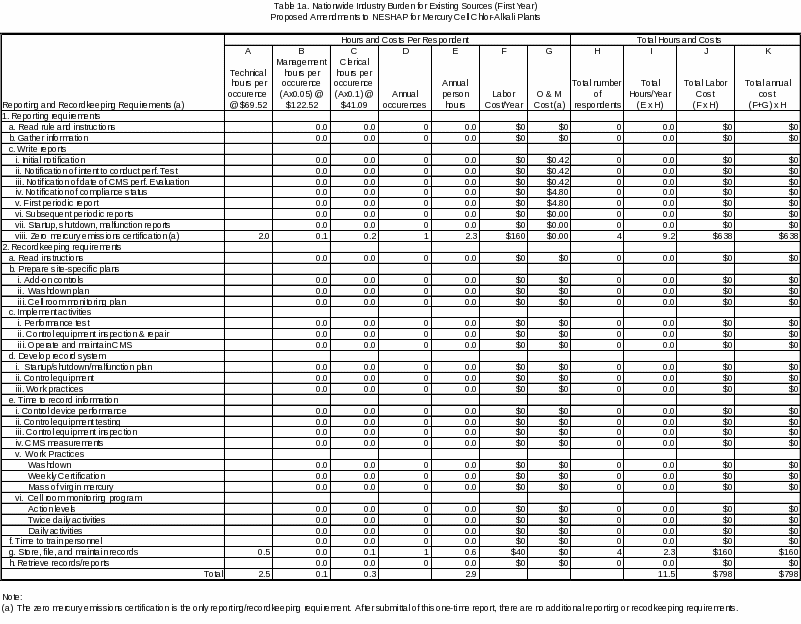

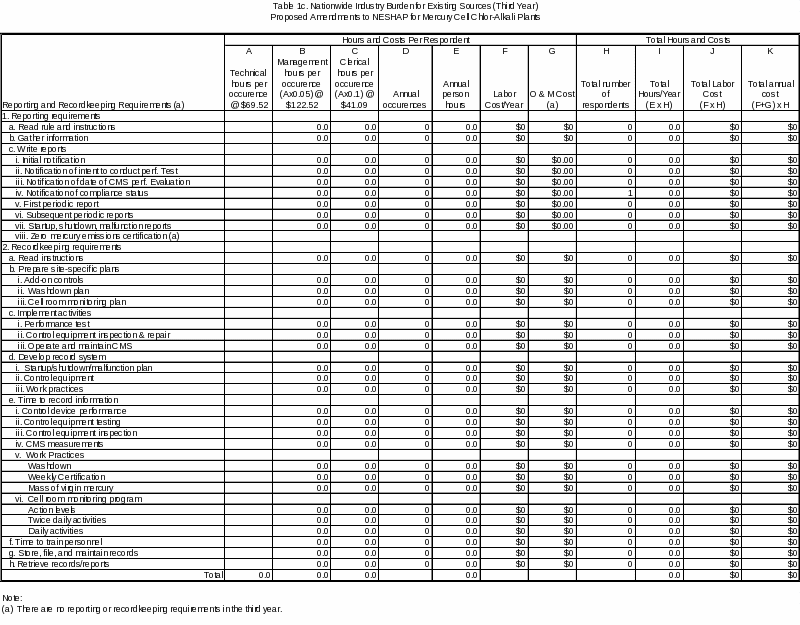
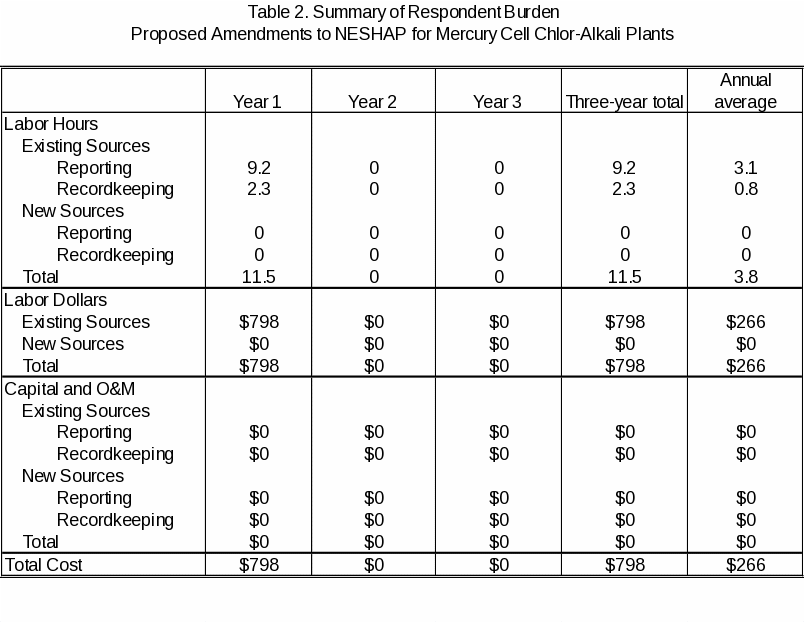
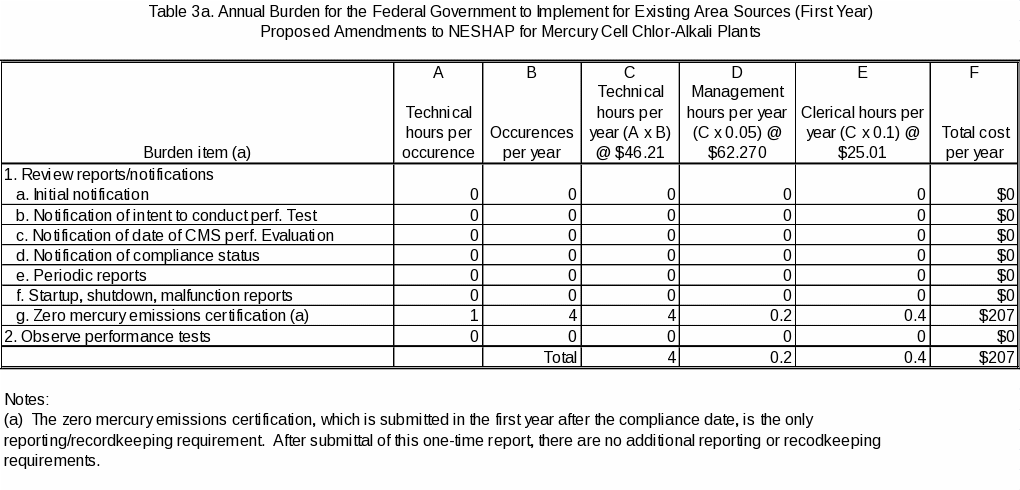
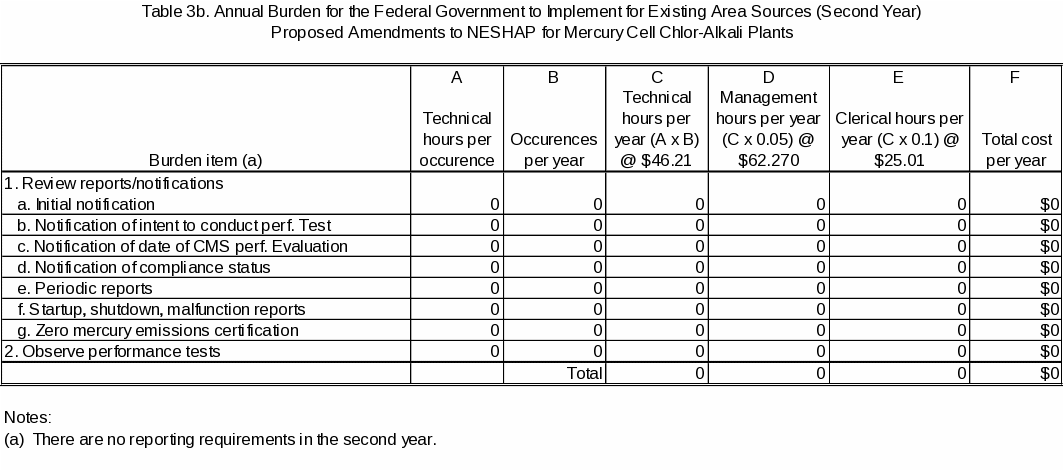
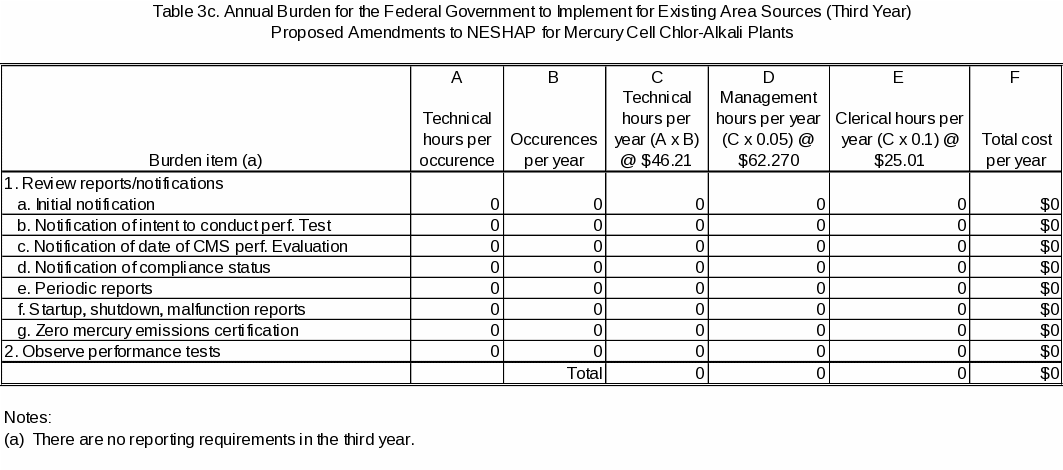

Attachment 1
Source Data and Information Requirements
Table 1-1. Reporting Requirements
Reporting Requirement |
40 CFR Part 63 |
Due Date |
Certification of zero mercury emissions |
'63.8252(f) |
60 days after the compliance date |
Table 1-2. Recordkeeping Requirements
Recordkeeping Requirement |
40 CFR Part 63 |
5-year retention of records |
'63.8258 |
Copies of notifications and reports and supporting documentation |
'63.10(b)(2)(xiv) |
Table 1-3. Respondent Activities
Respondent Activities |
40 CFR Part 63 |
Read instructions |
|
Write the notification listed in Table 1-1 abovea |
|
Record the information listed in Table 1-2 above |
|
Transmit or otherwise disclose information |
|
a One-time activities.
11This regulatory program was originally set forth at 38 FR 8826, April 6, 1973; and amended at: 40 FR 48302, October 14, 1975; 47 FR 24704, June 8, 1982; 49 FR 35770, September 12, 1984; 50 FR 46294, November 7, 1985; 52 FR 8726, March 19, 1987; and, 53 FR 36972, September 23, 1988.
| File Type | application/vnd.openxmlformats-officedocument.wordprocessingml.document |
| File Title | STANDARD FORM 83-I SUPPORTING STATEMENT |
| Author | Heather Brown |
| File Modified | 0000-00-00 |
| File Created | 2021-02-01 |
© 2025 OMB.report | Privacy Policy